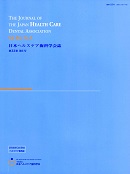Volume 23, Issue 1
The Journal Of The Japan Health Care Dental Association
Displaying 1-8 of 8 articles from this issue
- |<
- <
- 1
- >
- >|
General Remarks
-
2022Volume 23Issue 1 Pages 6-
Published: December 20, 2022
Released on J-STAGE: September 19, 2023
Download PDF (2948K) -
2022Volume 23Issue 1 Pages 17-
Published: December 20, 2022
Released on J-STAGE: September 19, 2023
Download PDF (1249K) -
2022Volume 23Issue 1 Pages 24-
Published: December 20, 2022
Released on J-STAGE: September 19, 2023
Download PDF (2201K) -
2022Volume 23Issue 1 Pages 31-
Published: December 20, 2022
Released on J-STAGE: September 19, 2023
Download PDF (1056K) -
2022Volume 23Issue 1 Pages 37-
Published: December 20, 2022
Released on J-STAGE: September 19, 2023
Download PDF (2054K)
Original Article
-
2022Volume 23Issue 1 Pages 47-
Published: December 20, 2022
Released on J-STAGE: September 19, 2023
Download PDF (2526K)
Survey Report
-
2022Volume 23Issue 1 Pages 57-
Published: December 20, 2022
Released on J-STAGE: September 19, 2023
Download PDF (1121K) -
2022Volume 23Issue 1 Pages 65-
Published: December 20, 2022
Released on J-STAGE: September 19, 2023
Download PDF (1526K)
- |<
- <
- 1
- >
- >|
